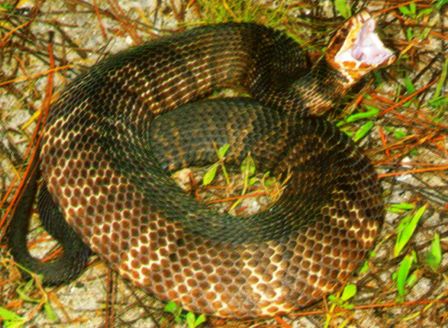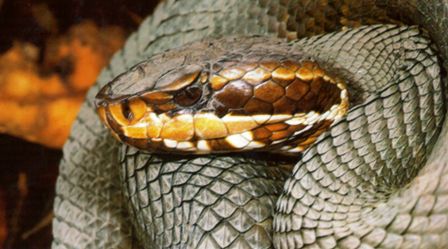Discover Florida Nature
It's time to explore the natural Florida


|
|
|
|
|
 The
Florida Cottonmouth or Water Moccasin, is a serpent that strikes terror
in the hearts of hikers, swimmers, and freshwater fishermen. This snake
is a heavy bodied pit viper with a large triangular head. The coloration
of the Cottonmouth is variable. Older and larger snakes tens to be
uniformly black, brown to reddish brown. the young are banded with a
dark color against a lighter background, and strongly resemble
Southern Copperheads, often
leading to the erroneous belief that Copperheads are found in South
Florida. The Cottonmouth has a dark stripe on its cheek that runs
through the eye. it's true coloration is often hidden by mud. Adult
Cottonmouth snakes are usually in the range of 30 to 48 inches. The
record length for the Florida Cottonmouth is 74.5 inches. The head of
the Cottonmouth is thick and distinctly broader than the neck, and when
viewed from above, the eyes cannot be seen. The top of this pit vipers
head in front of the eyes is covered with large plate-like scales. The
pupil is vertical and catlike. The
Florida Cottonmouth or Water Moccasin, is a serpent that strikes terror
in the hearts of hikers, swimmers, and freshwater fishermen. This snake
is a heavy bodied pit viper with a large triangular head. The coloration
of the Cottonmouth is variable. Older and larger snakes tens to be
uniformly black, brown to reddish brown. the young are banded with a
dark color against a lighter background, and strongly resemble
Southern Copperheads, often
leading to the erroneous belief that Copperheads are found in South
Florida. The Cottonmouth has a dark stripe on its cheek that runs
through the eye. it's true coloration is often hidden by mud. Adult
Cottonmouth snakes are usually in the range of 30 to 48 inches. The
record length for the Florida Cottonmouth is 74.5 inches. The head of
the Cottonmouth is thick and distinctly broader than the neck, and when
viewed from above, the eyes cannot be seen. The top of this pit vipers
head in front of the eyes is covered with large plate-like scales. The
pupil is vertical and catlike. Like all pit vipers, Cottonmouths have a deep facial pit between the nostril and the eye. The facial pits are extremely sensitive heat-detecting organs, with which the Water Moccasin can home in on warm blooded prey. The pit organs can detect differences in temperatures as small as three one-thousandths of a degree centigrade! Pit vipers produce a hemotoxic venom that destroys the blood cells of both warm-blooded and cold-blooded animals. The Cottonmouth is a rare exception when it comes to pit vipers because it is an aquatic snake. Most abundant in flooded woodlands, the Florida Cottonmouth is also found around rivers, streams and ponds. It is often seen along the water's edge, on the bank or on a log or rock. it can also be found unexpectantly in pine woods or other dry habitats. Though the Cottonmouth occurs throughout the state, it is not as abundant as the many species of harmless water snakes that occur in much the same habitat.  Unlike
the harmless water snakes, the Cottonmouth tends to hold it's ground
rather than go into the water, when approached. The Florida Cottonmouth
swims with his head well out of the water, a trait that other water
snakes don't have. Although it does not have rattles like a rattlesnake,
the Florida Cottonmouth often vibrates it's tail rapidly when annoyed.
When threatened, the Cottonmouth may respond by coiling its body and
opening its mouth as though ready to bite. The exposed white interior of
the mouth is what gave rise to the common name, ‘Cottonmouth.’ If not
hard pressed, the Cottonmouth usually will retreat. This open mouth
threat display has led to the widespread belief that Cottonmouths are
aggressive snakes. The Cottonmouth, or Florida Moccasin will strike
aggressively and it's venom is quite potent and potentially lethal! Unlike
the harmless water snakes, the Cottonmouth tends to hold it's ground
rather than go into the water, when approached. The Florida Cottonmouth
swims with his head well out of the water, a trait that other water
snakes don't have. Although it does not have rattles like a rattlesnake,
the Florida Cottonmouth often vibrates it's tail rapidly when annoyed.
When threatened, the Cottonmouth may respond by coiling its body and
opening its mouth as though ready to bite. The exposed white interior of
the mouth is what gave rise to the common name, ‘Cottonmouth.’ If not
hard pressed, the Cottonmouth usually will retreat. This open mouth
threat display has led to the widespread belief that Cottonmouths are
aggressive snakes. The Cottonmouth, or Florida Moccasin will strike
aggressively and it's venom is quite potent and potentially lethal! Florida Cottonmouths are excellent swimmers and feed primarily on aquatic species. Cottonmouths are carnivores, feeding on fishes, amphibians, birds, eggs, rodents, baby alligators, small turtles, and other snakes. These snakes are nocturnal, preferring to hunt at night. When catching frogs and fish, the cottonmouth holds its prey in its jaws until the venom takes effect. However, when capturing mammals, the cottonmouth bites, then releases the prey immediately because mammals are more likely to bite back. While the cottonmouth is capable of inflicting great damage through its bite, it rarely causes death in humans. People often wonder is the Water Moccasin can bite underwater, and the answer to that question is yes! Because of water resistance, the Water Moccasin cannot strike underwater in it's usual manner. If this snake is grabbed or stepped on in the water, the Cottonmouth would probably bite in self defense. If this serpent is in the water and swimmers are splashing about nosily nearby, then the Cottonmouth will probably try to swim away, but these snakes are not a problem in most swimming areas, since the Cottonmouth does not prefer clear open rivers and lakes. |
|
|
Advertise | Privacy Statement | Contact | Alaska Nature | Michael Arnold Art| Dog Encyclopedia | Dog Encyclopedia| |
|